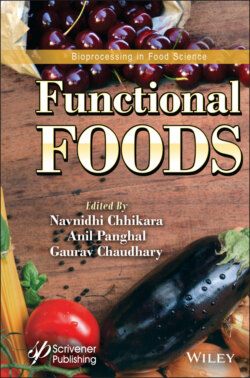Читать книгу Functional Foods - Группа авторов - Страница 39
3.2 Structure and Chemical Composition of Cereal Grains 3.2.1 Wheat
ОглавлениеAmong the most important grains in the world is wheat, produced annually at quantities reaching approximately 600 million tons. About 70% of this wheat is utilized for the production of foodstuffs [38, 39].
Triticum aestivum L., commonly known as wheat, is a grain comprising the 3 basic sections of an embryo (also known as the germ), endosperm, and pericarp (also known as the bran). A whole wheat kernel consists of 3% germ, 12% bran, and 82% endosperm [37, 40]. A wheat grain is about 8 mm long and weighs approximately 35 mg, while kernel size changes based on its location within the spike or the head of the plant, and also based on the cultivar. Wheat kernels have longitudinal folds on the ventral side, which run the length of the kernel. This fold makes it difficult for the bran to separate from the endosperm and keeps out both dust particles and various microorganisms. In the seed coat, there is pigmentation that gives the wheat kernel its coloring. Color is determined by genetics but is usually white or red. The grower may choose a preferred kernel color by genetic manipulation. The wheat kernel has an aleurone layer surrounding the endosperm, which is starchy in nature, and the germ. The bran and germ will be detached from the endosperm in the milling process. Most of the endosperm fraction (71%) is found in white flour. Amounts of the remaining parts of the endosperm, like the outermost layer of aleurone, are low [37].
Wheat bran has high mineral contents, as well as containing high levels of B vitamins. It also contains water and insoluble fiber, the presence of which protects the grain and the endosperm. Over half of the bran, or 53%, is made up of fiber components. Wheat bran fiber possesses a very complicated chemical composition, but it primarily comprises cellulose, pentosanes, and polymers based on arabinose and xylose that are bound closely to proteins. Such standard polymers are located within the wheat’s cell walls and cell layers like the aleurone layer. Both wheat bran carbohydrates and proteins account for 16% of wheat’s total dry weight. At the same time, wheat bran’s mineral contents are quite high (7.2%). In contrast, the pericarp and seed coat, which are the grain’s outermost layers, are composed of empty cells that are not alive. In the aleurone layer (i.e., the inner bran layer), cells are full of living protoplasts, which is why there is a large amount of carbohydrates and proteins in wheat bran. The amounts of amino acids in flour and in the aleurone layer vary dramatically. The levels of proline and glutamine in the aleurone layer are about half, the amount of arginine is three times, and the contents of asparagine, alanine, glycine, lysine, and histidine are twice that of wheat flour [41, 42]. Glutathione, alkylresorcinols, sulfur compounds, carotenoids, and α-linoleic acid are other key components of the bran. In wheat bran oil, steryl ferulates, tocopherols, alkylresorcinols, and other polyphenols are found [43, 44].
The endosperm layer of wheat is rich in energy-yielding starch. It contains proteins (13%) and fats (1.5%) apart from carbohydrates. Proteins in the endosperm of wheat are globulins, albumins, gliadins, and glutenins. Gliadins and glutenins are important proteins that make up gluten in dough-making. The mineral and dietary fiber contents of wheat endosperm are quite low. The mineral (ash) content is 0.5% and the dietary fiber content is 1.5% [42, 45].
Wheat germ has high levels of lipids (8%–13%), proteins (25%), and mineral substances (4.5%). At the same time, it represents a valuable source of vitamin E. While wheat germ contains 50% of the proline and glutamine content of the flour, its amounts of asparagine, arginine, alanine, glycine, threonine, and lysine have been measured to be twice as high [41, 42].
For dietary antioxidants, whole wheat and wheat bran both constitute valuable sources. The phenolic acids found in wheat, both free and esteri-fied, exert the largest influences among the health effects of wheat [22, 46, 47]. Phenolic acids, which are taken into the body with the consumption of a normal portion of whole wheat, exhibit marked antioxidant activities under in vitro conditions. The solubility and activity of wheat polyphenols are increased by acidic conditions and enzymatic hydrolysis [22, 46].
Whole wheat exerts many valuable health-promoting activities and effects. These are understood to be the result of the nutraceuticals and bioactive phytochemicals of whole wheat. The consumption of whole wheat and foods produced from it can reduce the risks of some chronic diseases, including type-2 diabetes mellitus, obesity, cardiovascular diseases, and cancers, especially colon cancer. This is achieved through both antioxidant and anti-inflammatory properties and gut microbiota modulation, as well as immunity improvement [48, 49].
